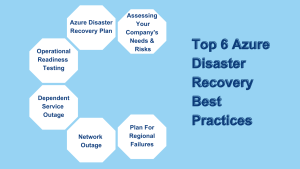Any disruption can be terrible for companies. Data breaches, outages, and natural disasters can cause operational disruptions, resulting in lost revenue, reputational damage, and decreased customer trust. To avoid this, companies focus more on improving their Disaster Recovery plans. According to a recent International Data Corporation survey, more than 88% of companies worldwide want to develop their disaster recovery plan in the cloud. Here’s where Azure Disaster Recovery enters in. This article will provide an overview of Azure disaster recovery and top Azure disaster recovery best practices.
What is Azure Disaster Recovery?
Disaster Recovery in Azure refers to the process of safeguarding data and apps against unanticipated outages or disasters. This service enables you to duplicate essential resources, such as virtual machines, databases, and applications, to a distinct Azure region. In the event of an incident in your primary zone, you can transfer to the backup region without downtime. It will provide operational continuity. This service includes automatic failover, constant replication, and recovery management. You can integrate these services using Microsoft Azure integration services to reduce downtime and maintain your company’s business continuity. Let’s further discuss Azure disaster recovery best practices.
Top 6 Azure Disaster Recovery Best Practices
Companies can maintain uninterrupted operations by sticking to these Azure disaster recovery best practices, which enable the automated restoration of services in the event of unforeseen events.

Assessing Your Company’s Needs and Risks
The first step is identifying your company’s requirements and possible risks in Azure disaster recovery best practices. This will serve as the foundation for your disaster recovery plan, ensuring that it perfectly aligns with your specific business environment and offers the required precautions against unexpected disruptions. By examining your company’s requirements and possible hazards, you can create a comprehensive disaster recovery strategy that prioritizes safeguarding what is essential. This strategy enables you to adapt your disaster recovery solutions to meet the particular dangers that your company faces properly.
Azure Disaster Recovery Plan
Create a detailed disaster recovery plan that specifies the actions required to restore your essential workloads in the case of a disaster. This plan should have the following critical elements:
- Evaluation: Your Disaster Recovery plan must be evaluated frequently to meet your changing company demands and risks. Regular risk assessments can help detect new threats or weaknesses.
- Support: To guarantee an effective DR process, you need to identify the roles and responsibilities of all team members engaged in the process. You should also develop communication protocols and escalation processes to guarantee that decisions are made promptly and informed during a crisis. Furthermore, external support providers can offer extra experience and resources.
- Automate: Automating Disaster Recovery tasks can significantly increase productivity while decreasing the risk of human error. Such duties include starting backups, failover processes, and notifying stakeholders. Azure offers various automation tools like Azure Automation and Azure Functions to accelerate disaster recovery procedures.
- Monitor: Continuous monitoring of your Azure infrastructure is critical to ensure the efficiency of your disaster recovery capabilities. Applying Azure Monitor and other relevant tools allows you to simply check the health of your resources, detect possible performance issues, and get warnings for defects.
Operational Readiness Testing
Regularly testing your disaster recovery plan is crucial to knowing its efficiency and identifying any weaknesses. This includes predicting crisis scenarios and testing your disaster recovery methods in a controlled environment. Actively testing your disaster recovery plan provides vital insights into its effectiveness and allows you to rectify flaws before a genuine crisis occurs. This proactive strategy instills trust in your DR capabilities and guarantees your business is ready to deal with any unexpected incidents.
Dependent Service Outage
The next one on the Azure disaster recovery best practices list is a dependent service outage. It is vital to consider the possible impact of dependent service outages. Many apps require other services to function correctly. Even if your core environment is working smoothly, an inaccessible dependent service can cause problems for your application. To avoid failures and decrease downtime for your important applications, you must take proactive steps to mitigate the potential effect of dependent service outages.
Network Outage
The Disaster Recovery Plan should specify what procedures to take for a network failure. Certain network elements might become unreachable, limiting your ability to access apps or data. Operating the applications with limited capability is the best solution in such scenarios. If decreasing functionality is not an option, you could consider failover to another location to avoid any application outage.
Plan For Regional Failures
Your plan for regional failure is last on the list of Azure disaster recovery best practices. Geographically distributed Azure regions have substantial benefits. However, it is crucial to note that entire regions could encounter outages. To overcome this issue, consider developing a multi-regional disaster recovery plan. Implementing such a plan can dramatically boost your company’s resilience while mitigating the impact of even massive regional outages.
Conclusion
In conclusion, leveraging Azure for disaster recovery enables organizations to ensure business continuity and minimize downtime during disruptions. They can create robust and trustworthy strategies by adhering to these Azure disaster recovery best practices leveraging the power of Azure. It not only enables businesses to navigate unforeseen events and disruptions confidently but also safeguards their mission-critical applications and services.

